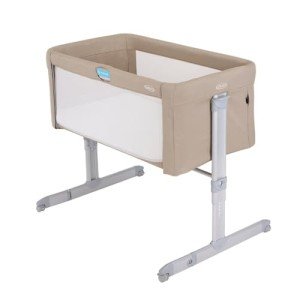Understanding Baby Co-Sleeper Cribs: A Comprehensive Guide
As new parents prepare for the arrival of their youngsters, the debate over sleeping arrangements frequently emerges. The choice between separate cribs, bed-sharing, and co-sleeping is a significant factor to consider. Recently, co-sleeper cribs have actually gained considerable appeal due to their perceived benefits for both parents and infants. This post will explore what baby co-sleeper cribs are, their benefits and disadvantages, how they compare to conventional cribs, and essential security standards.
What is a Baby Co-Sleeper Crib?
A baby co-sleeper crib, also understood as a bedside crib or sidecar crib, is developed to be put beside the moms and dad's bed. It enables parents to have their baby nearby throughout sleep without the risks related to bed-sharing. Bedside Cot For Close Bonding developed cribs frequently include adjustable height settings, security straps, and a detachable side panel, making them a convenient choice for nighttime feeding and soothing.
Secret Features of Co-Sleeper Cribs:
- Height Adjustability: Enables the crib to line up perfectly with the parents' mattress.
- Removable Side Panel: Facilitates easy access to the baby for feeding or soothing.
- Safety Straps: Secure the crib to the parent's bed to prevent any spaces.
- Compact Design: Saves space while providing convenience.
Benefits of Co-Sleeper Cribs
Co-sleeper cribs provide many benefits for both parents and babies.
- Benefit of Nighttime Feeding: The close proximity permits parents to more easily breastfeed or bottle-feed throughout the night.
- Promotes Bonding: Parents can more quickly comfort their babies, developing a strong psychological bond.
- Improved Sleep: Many parents find that having the baby close at hand decreases nighttime stress and anxiety, resulting in better sleep for everyone.
- Simpler Monitoring: Parents can keep a close eye on their baby while sleeping, guaranteeing they are safe and comfortable.
- Safer Alternative: Co-sleeper cribs decrease the dangers associated with bed-sharing, such as suffocation occurrences.
Table 1: Advantages of Co-Sleeper Cribs
| Advantage | Description |
|---|---|
| Convenience of Nighttime Feeding | Ease of access for breastfeeding or calming babies during the night. |
| Promotes Bonding | Improved emotional connection through distance during sleep. |
| Enhanced Sleep | Decreased parental anxiety results in a more peaceful night. |
| Simpler Monitoring | Localized view improves reassurance for parents. |
| More secure Alternative | Lower danger of suffocation compared to bed-sharing. |
Drawbacks of Co-Sleeper Cribs
While co-sleeper cribs come with numerous benefits, they likewise have some drawbacks.
- Limited Use: Co-sleeper cribs are typically just used for the first six months or so, until the baby begins to move around.
- Expense: Quality co-sleeper cribs can be more pricey than standard cribs.
- Space Constraints: A co-sleeper crib requires sufficient space next to the adult bed, which may not be offered in smaller spaces.
- Feasibility for Larger Adults: Some grownups might find it uneasy to lean over the crib for nighttime needs.
Table 2: Disadvantages of Co-Sleeper Cribs
| Disadvantage | Description |
|---|---|
| Minimal Use | Usable just for a brief time till the baby grows. |
| Expense | Higher price point compared to conventional choices. |
| Space Constraints | Requires sufficient space adjacent to the adult bed. |
| Feasibility for Larger Adults | May trigger pain when reaching over for nighttime care. |
Comparing Co-Sleeper Cribs to Traditional Cribs
The choice between co-sleeper cribs and standard cribs greatly affects the parenting experience.
Secret Differences:
| Feature | Co-Sleeper Crib | Traditional Crib |
|---|---|---|
| Proximity | Beside parent's bed | Separate room |
| Accessibility | Easy grab nighttime care | Requires rising |
| Duration of Use | 0-6 months, depending on development | Generally used for several years |
| Size | Compact and space-saving | Typically bigger and more steady |
Safety Guidelines for Co-Sleeper Cribs
To ensure the safest sleeping plan, parents ought to comply with specific security guidelines when utilizing a co-sleeper crib:
- Secure the Crib: Use security straps or securing systems to secure the co-sleeper to the adult bed, lessening space between the two.
- Use a Firm Mattress: Make sure the bed mattress is firm and fits snugly within the crib.
- Prevent Soft Bedding: Minimize the use of soft items such as pillows, blankets, or packed toys in the crib.
- Screen Baby's Movement: Stay mindful to how the baby moves throughout sleep.
Frequently Asked Questions about Baby Co-Sleeper Cribs
Q1: Are co-sleeper cribs safe?
A1: Yes, when utilized according to security standards, co-sleeper cribs can supply a safe sleep environment while keeping the baby near to the parents.
Q2: How long can I use a co-sleeper crib?
A2: Co-sleeper cribs are normally developed for use from birth until the baby is around 6 months old or can press themselves up.
Q3: Can I use a co-sleeper crib if I have a small bed room?
A3: Yes, most co-sleeper cribs have a compact design, making them suitable for small spaces.
Q4: Do co-sleeper cribs need assembly?
A4: Most co-sleeper cribs need some assembly, but the procedure is normally straightforward and accompanied by guidelines.
Q5: What should I do if my baby outgrows the co-sleeper?
A5: Transition your baby to a standard crib in their own room or a nearby place that complies with safe sleep guidelines.
Baby co-sleeper cribs offer an engaging choice for parents who wish to keep their infants close by during sleep. They offer numerous benefits, including ease of nighttime feeding and cultivating close bonds. However, like all parenting options, it's necessary to weigh the advantages and drawbacks and think about private living circumstances and choices. By adhering to security guidelines, parents can create a protected sleep environment for their children, making sure assurance for the entire family.

